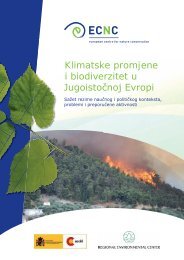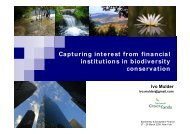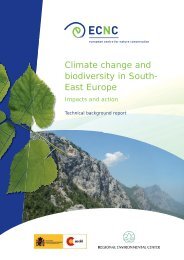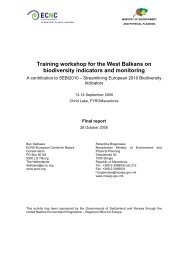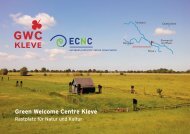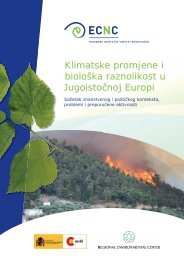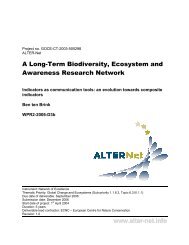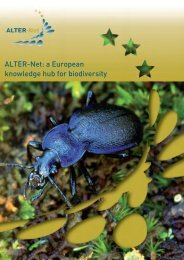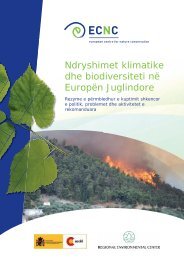2005 - Communicating the Pan-European Ecological Network - ECNC
2005 - Communicating the Pan-European Ecological Network - ECNC
2005 - Communicating the Pan-European Ecological Network - ECNC
Create successful ePaper yourself
Turn your PDF publications into a flip-book with our unique Google optimized e-Paper software.
In Germany nature conservation by law is a task of <strong>the</strong> federal states. Accordingly in each of <strong>the</strong> federalstates initiatives concerning <strong>the</strong> development of ecological networks have started at different times andhave so far mostly been developed independently. Here <strong>the</strong> nor<strong>the</strong>rnmost state, Schleswig-Holstein, hastaken a leading role. There is a requirement for <strong>the</strong> establishment of a functional ecological network on atleast 15% of its surface area, which has been included in its nature conservation policy for a long timealready. Accordingly plans for ecological networks exist for all of Schleswig-Holstein on various spatialscales and <strong>the</strong> implementation is making good progress. Ano<strong>the</strong>r state, Rheinland-Pfalz, also needs to bementioned, because plans for ecological networks covering its entire surface area were developed veryearly on.The new version of <strong>the</strong> Federal Nature Conservation Act came into force in Germany in April 2002.This included <strong>the</strong> new article, article 3, which obliges each of <strong>the</strong> German federal states to assign at least10 % of its surface area to <strong>the</strong> development of an ecological network. This article also says that <strong>the</strong> aimsof such a network are mainly functional, i.e. to secure <strong>the</strong> conservation of species, communities and habitatsas well as <strong>the</strong> preservation, regeneration and development of functioning ecological interactions. Thisarticle also outlines which functional components and types of sites should or might be part of <strong>the</strong> ecologicalnetwork, and lists different options of securing <strong>the</strong>se as part of an ecological network.The federal states were obliged to implement this article in <strong>the</strong>ir respective nature conservation acts byApril <strong>2005</strong>. So far only some of <strong>the</strong> federal states have achieved this. The federal states are obliged todevelop such ecological networks in a consistent way working toge<strong>the</strong>r across federal state borders.Although article 3 of <strong>the</strong> Federal Nature Conservation Act does give an outline of what <strong>the</strong> goals of <strong>the</strong>establishment of ecological networks are, it does not tell in detail how <strong>the</strong>se goals are to be reached.A working group consisting of representatives of <strong>the</strong> nature conservation agencies of <strong>the</strong> federal statesand <strong>the</strong> national agency was formed in order to develop criteria for a consistent implementation of thisarticle. This working group mainly focused upon <strong>the</strong> development of a system of criteria serving to selectsites that already contribute to an ecological network and sites that are needed in addition and accordinglyshould be developed for this purpose. The working group also commented on which of <strong>the</strong>se sitesshould be considered as part of <strong>the</strong> 10% of <strong>the</strong> surface area demanded. Guidance was also providedabout <strong>the</strong> suitability of different legal means of conservation for securing <strong>the</strong> long-term functioning of <strong>the</strong>components of ecological networks.Some of <strong>the</strong> federal states had already produced maps for ecological networks within <strong>the</strong>ir borders beforethis system of criteria was developed. In some cases <strong>the</strong> designed networks fulfil <strong>the</strong> criteria quite well,in o<strong>the</strong>r cases <strong>the</strong> networks will need some adaptation.All of <strong>the</strong>se maps have been put toge<strong>the</strong>r using GIS and serve as a base for a research-project that hasjust started and aims at selecting core areas and ecological corridors of national and international importance.Assessment of policy and legislation in support of PEENThere is clear support for <strong>Ecological</strong> <strong>Network</strong>s in German federal law. Implementation of ecological networkstakes place at <strong>the</strong> ‘Länder’ (federal states) level. There is also strong support for <strong>the</strong> internationaldimension of <strong>the</strong> German federal ecological network and it appears that <strong>the</strong> Bundesamt für Naturschutz(national nature authority) is very active in <strong>the</strong> identification of new methods of how those actors involvedin implementing <strong>the</strong> ecological network can cooperate with <strong>the</strong>ir international partners.Assessment of legislation and policy in respect CEPA ActivitiesWhilst <strong>the</strong> CEPA Activities of <strong>the</strong> Nature Conservation Act were not prescriptive in <strong>the</strong> review, <strong>the</strong> text doesindicate that <strong>the</strong> government are looking at how to involve necessary actors, and more specifically beginningto look at which actors are necessary for cross border cooperation.75



